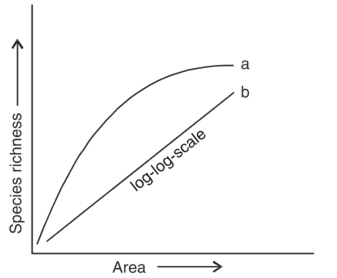 Short Answer Type
Short Answer TypeThe following graph shows the species – area relationship. Answer the following questions as directed

(a) Name the naturalist who studied the kind of relationship shown in the graph. Write the observations made by him.
(b) Write the situations as discovered by the ecologists when the value of ‘Z’ (slope of the line) lies between (i) 0.1 and 0.2 (ii) 0.6 and 1.2 What does ‘Z’ stand for ?
(c) When would the slope of the line ‘b’ become steeper ?
(a) List any three ways of measuring population density of a habitat.
(b) Mention the essential information that can be obtained by studying the population of an organism. Long Answer Type
Long Answer Type(a) Explain giving reasons why the tourists visiting Rohtang Pass or Mansarovar are advised to resume normal active life only after a few days of reaching there.
(b) It is impossible to find small animals in the polar regions. Give reasons.
(a) Tourists visiting high altitude areas such as Rohtang Pass or Mansarovar, experience altitude sickness. Its symptoms include nausea, fatigue and heart palpitations. This is because in the low atmospheric pressure of high altitudes, the body does not get enough oxygen. But, gradually we get acclimatised and stop experiencing altitude sickness. The body compensates low oxygen availability by increasing red blood cell production, decreasing the binding affinity of hemoglobin and by increasing breathing rate. Thus, the visitors are advised to resume their normal active life involving heavy works only after few days because for doing heavy tasks our body needs energy and this energy is obtained by the oxidation of glucose in the presence of oxygen which is a limiting factor in higher altitudes.
(b) Smaller animals are rarely found in Polar Regions because small animals have a larger surface area relative to their volume. Since heat loss or heat gain is a function of
surface area, they tend to lose body heat at a very fast rate when it is cold outside; because of which they have to expend much energy to generate body heat through metabolism. Short Answer Type
Short Answer Type Long Answer Type
Long Answer Type(a) Name the two growth models that represent populations growth and draw the respective growth curves they represent.
(b) State the basis for the difference in the shape of these curves.
(c) Which one of the curves represent the human population growth at present ? Do you think such a curve is sustainable ? Give reason in support of your answer.
 Short Answer Type
Short Answer TypeDuring a school trip to 'Rohtang pass' one of your classmate suddenly developed 'Altitude sickness'. But, she recovered after sometime.
(a) Mention one symptom to diagnose the sickness.
(b) What causes the sickness?
(c) How could she recover by herself after sometime?
 Long Answer Type
Long Answer Type(a) Represent diagrammatically three kinds of age-pyramids for the human population.
(b) How does an age pyramid for human population at given point of time helps the policy makers in planning for the future.
 Short Answer Type
Short Answer TypeWater is very essential for life. Write any three features both for plants and animals which enable them to survive in water scarce environment.
How do organisms cope with stressful external environmental conditions which are localised or of short duration?
